Best Fishing Pliers Review & Buyer’s Guide
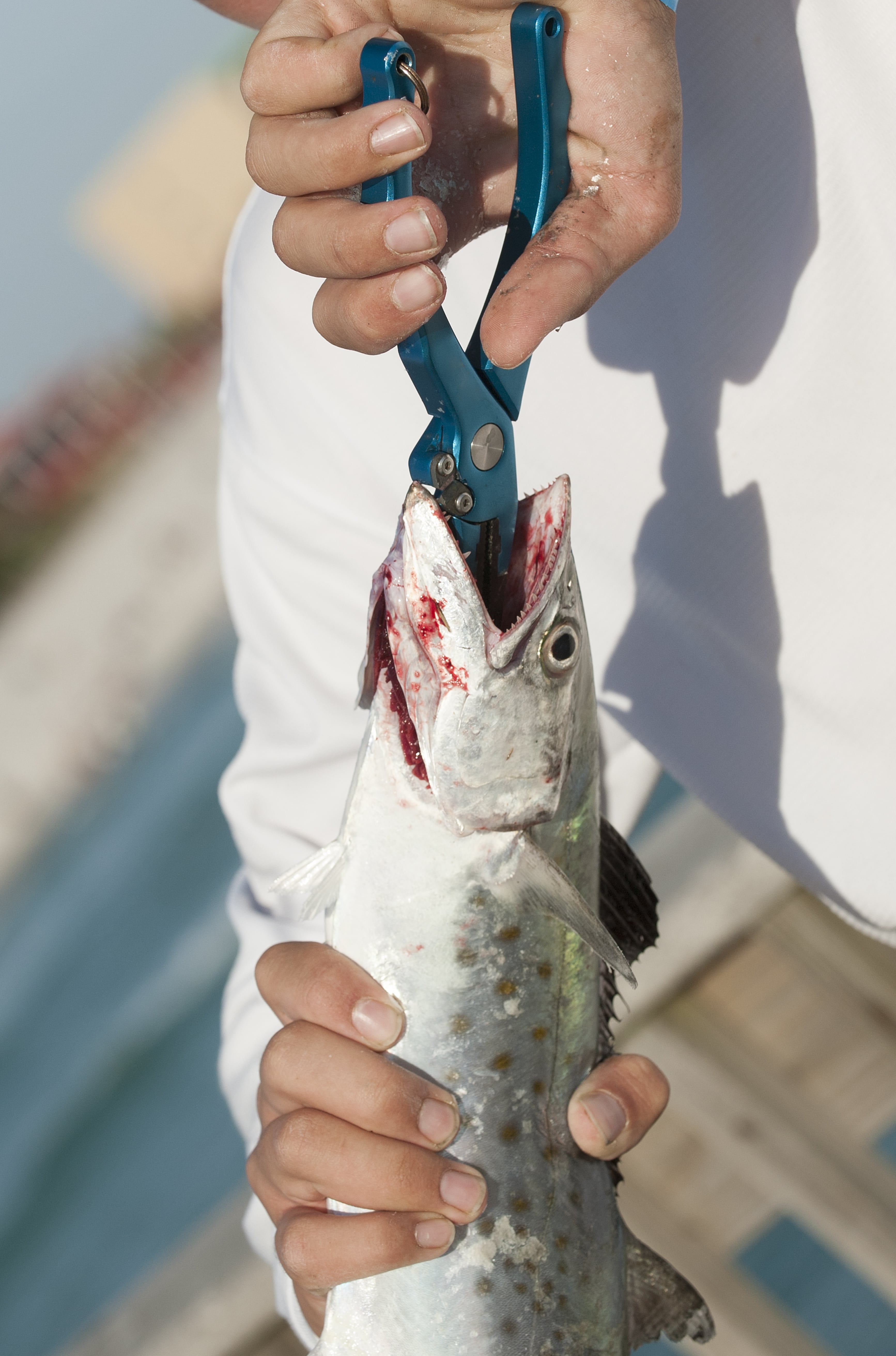
Having a good pair of pliers can really come in handy on the water. Whether you’re reeling in lots of fish and need to deal with the hooks, or you’re cutting lots of braid and want something easy and accessible for that, pliers are almost essential for all anglers.
Some fishermen prefer bent nose pliers, while others like a more standard design. Most have the common interest in being able to cut braid, and other less essential features can make a difference as well, such as brightness, weight, durability, ergonomics, and overall size.
Of course, price is a factor that many of us would love to not have to consider, but when it comes down to it, we’re all on a budget somehow. In this article, we will provide our top picks for the best fishing pliers with a focus on value. Therefore, we will provide an overview of pliers at a few different price points, hopefully providing some useful information as to how pliers can vary and whether or not it’s worth forking out a few extra bucks for something higher end.
Reviews – Best Fishing Pliers
Basic
South Bend Bent-Nose Fishing Pliers
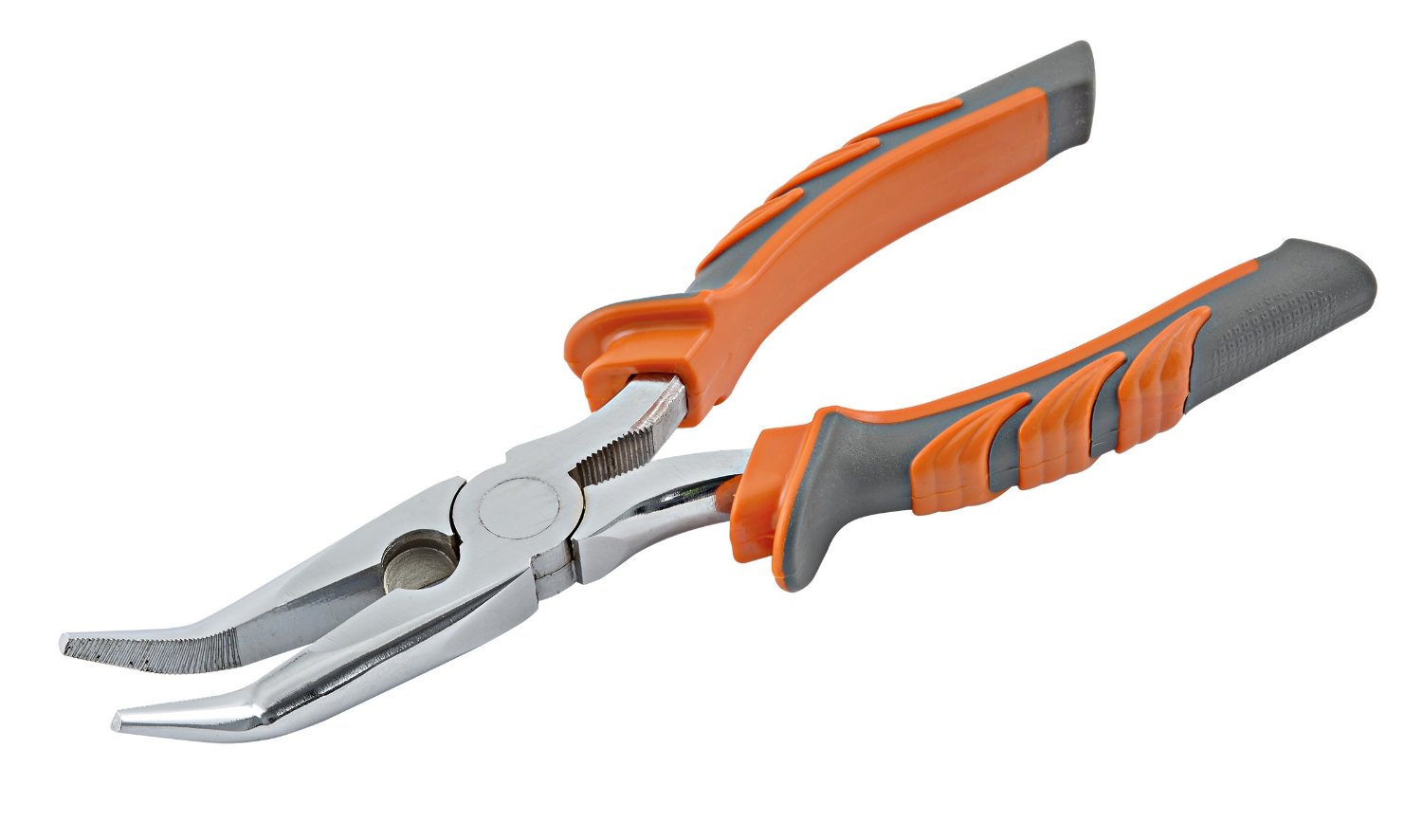
Pros
- Very low price
- Standard design with bent nose for easier removal of hook
- Design includes wire cutters
- Good quality for the price
- High carbon steel with chrome plated finish
Cons
- A little bulky, especially when removing hooks from smaller fish
- Wire cutters are nice, but not the best for braid
- Need to be rinsed thoroughly after use in saltwater
General Consensus
The South Bend Bent Nose fishing pliers are your basic pair of fishing pliers. Simply put, they help get the job done and are definitely useful, but don’t offer anything special.
One huge advantage of these pliers is the cost. You can often find them for well under $10, and it’s not like you’re getting a cheap pair of plastic kid toy pliers. These are crafted with high carbon steel and a chrome-plated finish, so they’re definitely sturdy, but the main drawback here is they are more prone to corrosion. You will need to rinse them off thoroughly after use in saltwater, otherwise they will rust quite quickly.
The 8-inch length is nice because the average size makes them applicable in lots of situations, the bent nose design can also come in handy sometimes when removing hooks, and the soft-rubber coated handles provide good grip. The wire cutters can be used for fishing line, but given they are a bit thicker and not meant exactly for that purpose, you may still need to put in a little work to cut braided line.
Overall, these South Bend fishing pliers offer tremendous value, but don’t offer too much more than a standard pair of pliers. We would recommend these fishing pliers for anyone who is looking for something cheap and simply wants to get the job done, and is ok with the pliers being a little more bulky than some others.
Mid-Range
Freehawk Multi-Function Fishing Pliers
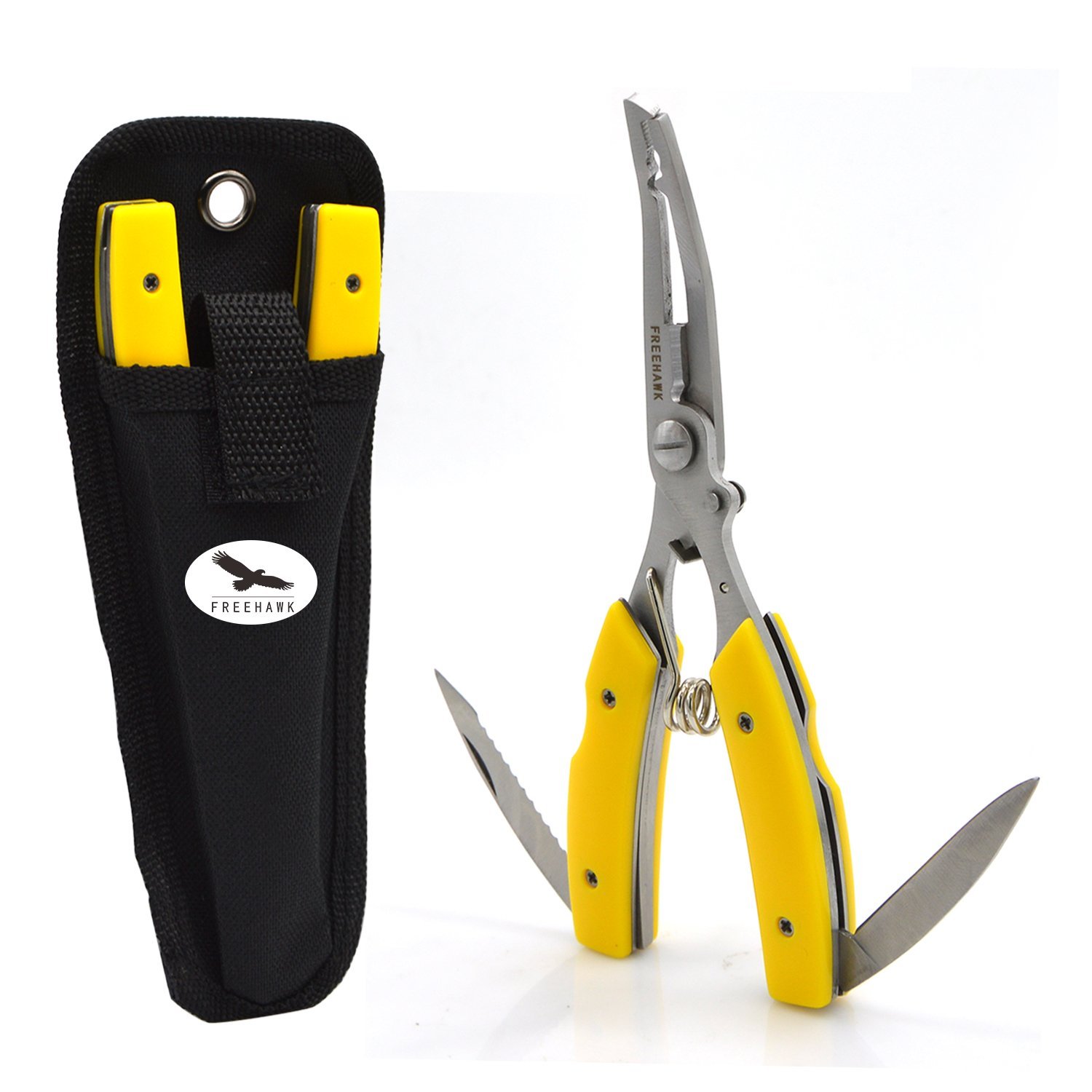
Pros
- Bent nose stainless steel pliers great for hook removal
- Low price
- Cutters work well for braided line
- 2 small blades included
Cons
- Some anglers find these pliers to be a little small
- Blades aren’t the sharpest
General Consensus
The Freehawk Multi-Function fishing pliers offer excellent bang-for-your-buck. These are definitely on the cheaper end for fishing pliers, but yet they still function well and incorporate some additional features that can come in handy.
One of the main things to know about these pliers is they are rather small, coming in at a length of about 6.5 inches. That being said, they are still quite sturdy, and this also makes them a little more portable which is nice.
The “ergonomic” handles aren’t anything special, but they do provide decent grip, which we tend to prioritize over slightly increased comfort. Given they are entirely steel, they are a little heavier than some higher-end pliers, but we don’t really care about that. The blades aren’t as sharp as they could be, but they do the trick.
Overall, the Freehawk Multi-Function fishing pliers offer excellent value. Simply put, they get the job done, are known to be quite durable, and incorporate a couple extra handy features as well. We would recommend these fishing pliers to any angler who is looking for a good pair of pliers, but don’t anything overly fancy. They’re great for anyone looking to save a couple bucks, just remember they are slightly smaller than most fishing pliers (not by much).
High-End
Zitrades FP-20 Aluminum Fishing Pliers
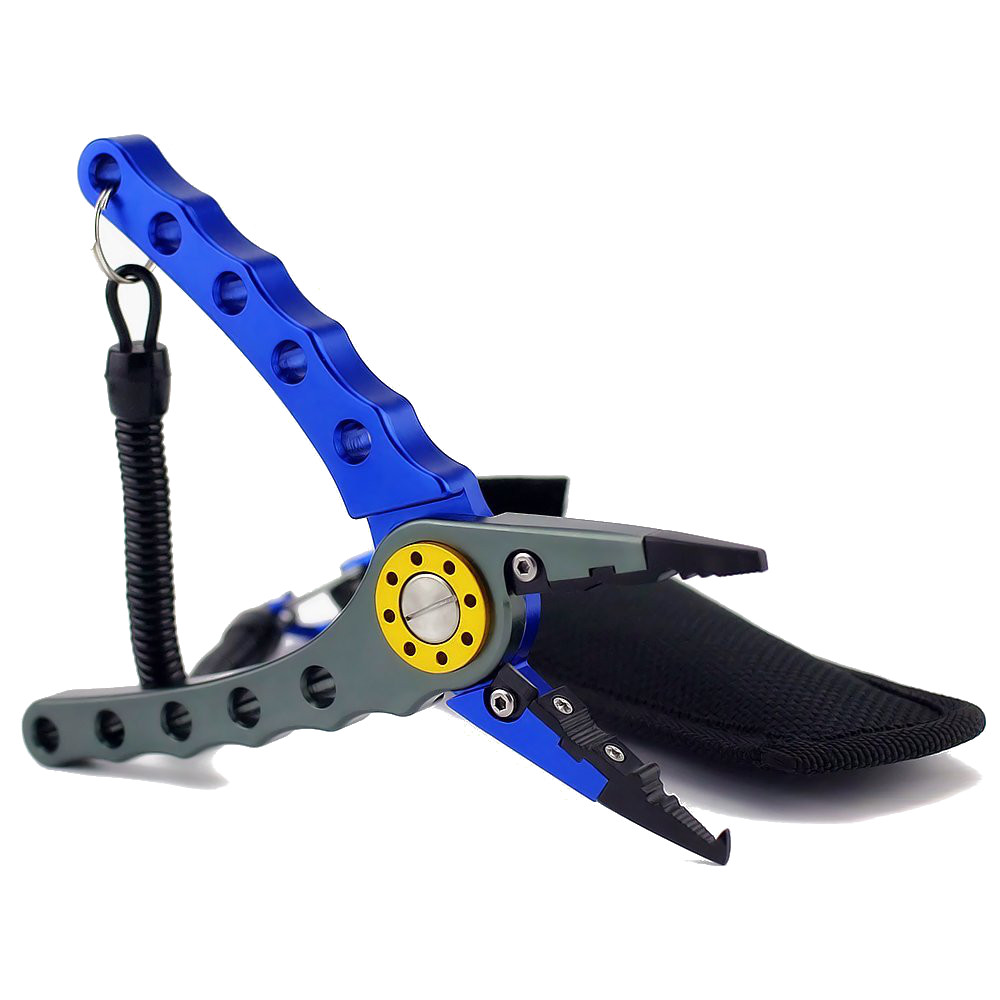
Pros
- Moderately priced
- Aluminum alloy body, stainless steel jaws, CNC-machined
- High density skid-proof handle
- Lightweight and bright
Cons
- Can’t achieve full closure (teeth do not firmly touch)
- Internal ring susceptible to rust
- Smooth handles can be slippery
General Consensus
The Zitrades FP-20 aluminum fishing pliers could be considered a mid-range to high-end pair of fishing pliers. The are a sturdy pair of 7-inch CNC-machined anodized pliers that incorporate an aluminum body and stainless steel jaws (.SUS 420).
The precision-sharpened tungsten carbide cutters on these pliers are awesome and are really sharp out of the box, so they’re great for all line types including mono, braid, and fluoro.
The main complaint about these pliers are the susceptibility to corrosion to the split ring, but if you find this to be an issue, you can get a stainless steel replacement ring for dirt cheap. The other issue, which we find to be a little more important, is the handle smoothness. It’s ok when they’re dry, but with wet hands and after handling fish, these are definitely a little more slippy than some other pliers.
Overall, the Zitrades FP-20 aluminum pliers are great, and while they are entering a slightly higher price point, they do offer good value. The 7″ length makes them applicable for a wide range of situations, they are easy and comfortable to use (the drier, the better), and they incorporate high-grade materials. We would recommend these pliers to any angler looking for a sturdy pair of high performance fishing pliers and are ok with spending a little more for them.
Pro
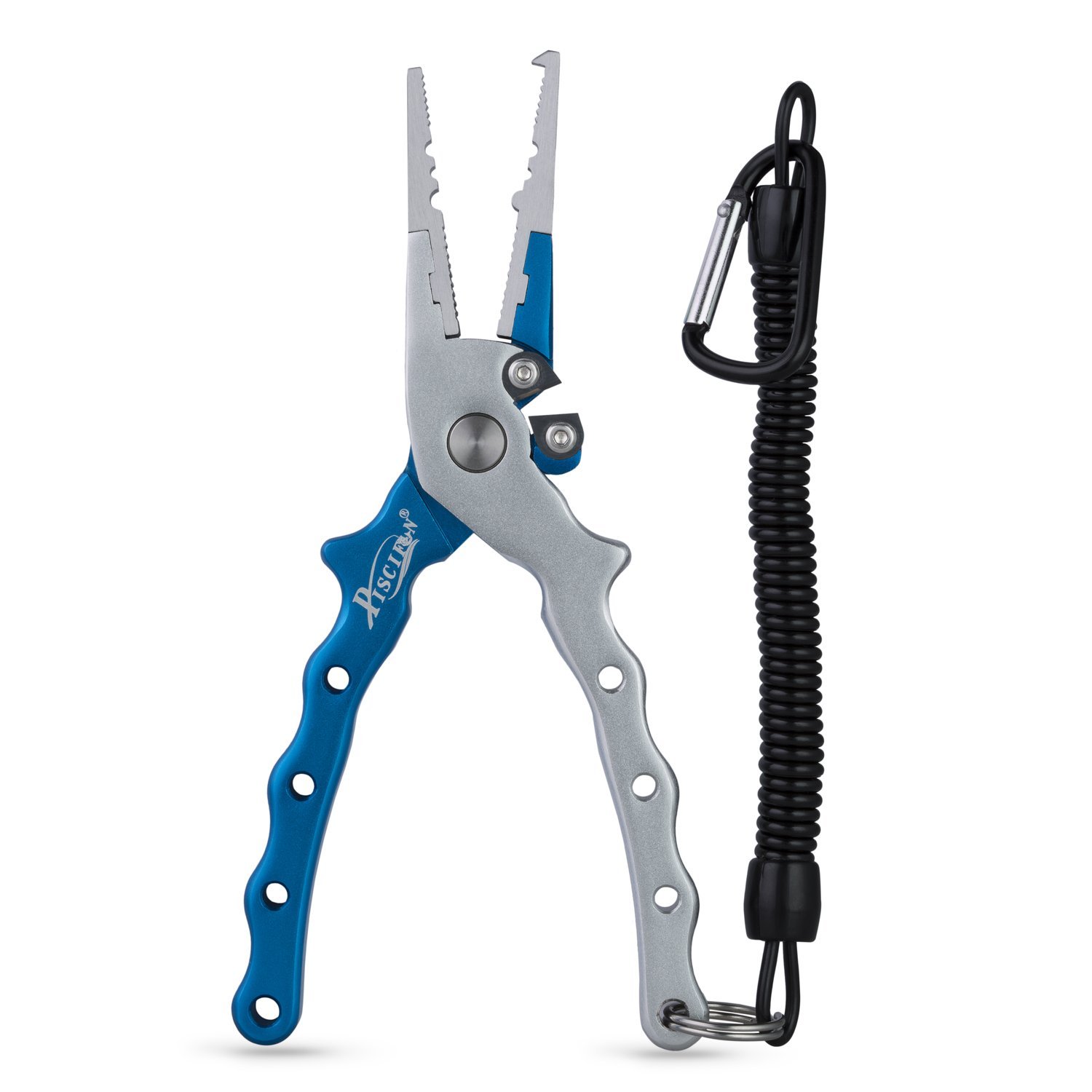
Pros
- Anodized aircraft-grade aluminum
- Ergonomic grip
- Titanium-coated stainless steel jaws
- Replaceable titanium-coated tungsten carbide cutters
- Includes woven nylon belt holster
Cons
- Expensive
- Sheath seems a little cheap
- Line cutter is a little high up on the blade with a gap at the bottoms, which can be slightly annoying at times
General Consensus
These Piscifun fishing pliers boast some of the best specs you will find in a pair of fishing pliers. They are great for both freshwater and saltwater, incorporate quality construction, and are comfortable and lightweight.
One thing to keep in mind is that these pliers are 6.7 inches, and while the jaws are made of titanium-coated stainless steel aluminum, the handles are made of aluminum in order to decrease weight while still providing resistance to corrosion. The only issue here is that they may be better suited for “smaller” fish, maybe under 25 lbs or so, at least for long term use.
The line cutter works really well, better than most pliers, and can easily handle mono, braided, and fluorocarbon line. The only slightly annoying issue is that the cutters are a little high up, and there is a gap behind, so if it’s dark or you’re not paying close attention it can be easy to slide the line into that gap. This is a picky issue, but something to be aware of nonetheless.
These fishing pliers are also quite expensive compared to other pliers. They’re definitely great and you can see and feel the quality that comes with the price, but we wouldn’t consider the value to be quite as high as some of the cheaper pliers.
Overall, these are an excellent pair of fishing pliers that perform well, are durable, and are lightweight and comfortable to use. We would recommend the Piscifun fishing pliers to anglers who are willing to pay more for the quality and don’t need something overly long.
Difference Between Freshwater and Saltwater Fishing Pliers
Fortunately, choosing a pair of fishing pliers isn’t overly complicated, especially since they run cheaper than lots of other fishing gear. That being said, there are a few key points to keep in mind that may help with a decision.
One of the most common inquiries about fishing pliers is what differs between freshwater pliers and saltwater pliers. This pretty much comes down to material. Standard pliers and some cheaper fishing pliers will be made of various types of steel, which is a very strong and practical material to select for pliers. The issue here is that lots of variations of steel can be prone to corrosion in saltwater. “High-carbon steel” is an example of this, where the company wants to market the product as sounding advanced, when in actuality it’s pretty standard.
So is all steel prone to corrosion? No, but as you might have expected, corrosion-resistant steel is more expensive. The primary type of steel used in this case is stainless steel, and you may often see it marketed as “titanium-coated”, where titanium is another metal resistant to corrosion.
Aluminum is another corrosion-resistant material. It’s also a very practical metal, as many manufacturers are familiar with crafting products using various aluminum alloys. Aluminum is also great in reducing the weight of the pliers, but it also comes at the cost of reduced strength compared with stainless steel.
This is one of the reasons why you may often see pliers with aluminum handles and stainless steel jaws. At least half of the material in this case is aluminum, which cuts down on the weight while still providing resistance to corrosion, and the stainless steel up front ensures high strength at the jaws.
One thing to keep in mind is that no set of fishing pliers is absolutely perfect. Over time, mother nature will take it’s toll on the pliers, especially after heavy saltwater use in saltwater. In order to prolong the lifespan of your fishing pliers, we highly suggest rinsing them thoroughly immediately after use in saltwater. If you eventually find that they are sticking too much, a little bit of WD-40 can usually do the trick!
What Does “Anodized” Mean?
You may see the term “anodized” preceding a type of metal in the product description of a pair of pliers. In short, anodized is a good thing, and it essentially means that your pliers will be more resistant to rust.
Anodization is an electrochemical process that involves immersing the metal in an electrolytic acid and passing a current through. This complicated process has become quite standard in many different engineering applications. In regards to fishing pliers, aluminum and titanium are the most commonly anodized materials.
Anodization also serves another practical purpose, which is better bonding for paint or dyes. While you may not be able to tell with the naked eye, an anodized surface contains a higher concentration of surface pores, which allows paint or dyes to be able to stick to the object. This can make for a great looking paint job on metal that doesn’t just immediately start chipping.
Line Cutters
Cutting line isn’t the fundamental principle of pliers, but it certainly provides an extra level of convenience and is now fairly standard on any pair of fishing pliers. If you don’t have line cutters on your fishing pliers, you can upgrade for a very low cost.
Line cutters are usually more precisely sharpened on the higher-end pliers, but even more dull line cutters or standard wire cutters can do the trick. Worst case, you have to use your teeth a little bit with thicker line like braid, but most line cutters shouldn’t have a problem with that.
While we say that wire cutters can often be used for line, the opposite is not recommended. If you use your fishing pliers for cutting wire, it may still work, but the blades will become dull quite quickly and may actually damage them as well.
Handles
The essential components of fishing pliers handles are easy to understand. Even just imagining using a pair of fishing pliers you can probably guess the more important aspects: grip and comfort.
Flat and smooth handles will provide the least amount of grip, and if you have wet hands and are handling fish, this will be a problem. So with fishing pliers, try and look for handles that have grooves for your fingers, or a textured coating (ideally soft rubber) that will provide additional traction. Ideally you will have both, but even just including one can make a big difference in grip.
These qualities will also help enhance comfort, or the “ergonomics” of the pliers. We don’t pay too much attention to this, as we prioritize having a product that works rather than one that feels nice, but if you can get both, then why not!
